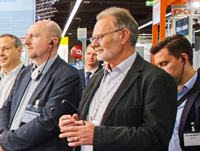
Comunicato
The Technical Committee of the EtherCAT Technology Group (ETG) has accepted EtherCAT G as an addition to the EtherCAT standard. Moving forward, EtherCAT G, which extends EtherCAT technology to 1 and 10 Gb/s, respectively, will be supported and promoted by the ETG.
EtherCAT G was introduced by Beckhoff Automation in 2018 as an extension of the EtherCAT standard. Beckhoff recently presented the gigabit technology addition to the ETG, and after thorough review, the organization’s Technical Committee accepted it. Right now, the ETG is working to add EtherCAT G to the corresponding technology specifications. Dr. Guido Beckmann, Chairman of the ETG Technical Committee, explains why ETG welcomes the active integration of EtherCAT G into ETG: “EtherCAT is already the fastest industrial Ethernet fieldbus, and will remain so due to its special functional principle. With EtherCAT G, particularly data-hungry applications, such as machine vision and high-end measurement technology, can now also be integrated. This extends the range of applications for EtherCAT technology and makes it even more viable for the future.”
The well-known 100 Mb/s EtherCAT technology remains the proven solution for the majority of applications. However, EtherCAT G offers additional user advantages, especially in applications where particularly large amounts of process data must be transported per device. This can include, for example machine vision, high-end measurement technology or complex motion applications that go beyond the scope of classic drive control. As an extension of standard EtherCAT technology, EtherCAT G is fully compatible; existing devices designed for 100 Mb/s can be seamlessly integrated into an EtherCAT G system, and EtherCAT G devices in a 100 Mb/s EtherCAT system behave like classic EtherCAT devices.
The central element of EtherCAT G is the use of EtherCAT Branch Controllers, which essentially fulfil two main functions: On the one hand, they act as a kind of node for the integration of segments from 100 Mb/s devices; on the other hand, they enable parallel processing of the connected EtherCAT segments. This significantly reduces the propagation delay in the system, which increases system performance many times over previous levels.
Typical for EtherCAT: The integration of EtherCAT G is simple, as the extension is fully compatible with the IEEE 802.3 Ethernet standard and no software adaptions in controllers are required for the standard mode. “The advantages of EtherCAT are well known and include processing on the fly, comprehensive diagnostics, simple configuration and integrated synchronization,” says Beckmann. “These attributes are of course fully retained when EtherCAT G is used.”
Didascalia immagine
This example network architecture incorporates standard EtherCAT, EtherCAT G and EtherCAT G10 for faster communication and greater data throughput. (picture credit: Beckhoff Automation)

Contatti Stampa
Per ulteriori informazioni in merito alle pubbliche relazioni si prega di contattare l'indirizzo: press@ethercat.org
Archivio Stampa
Archivio Stampa 2018
Archivio Stampa 2017
Archivio Stampa 2016
Archivio Stampa 2015
Archivio Stampa 2014
Archivio Stampa 2003-2013

